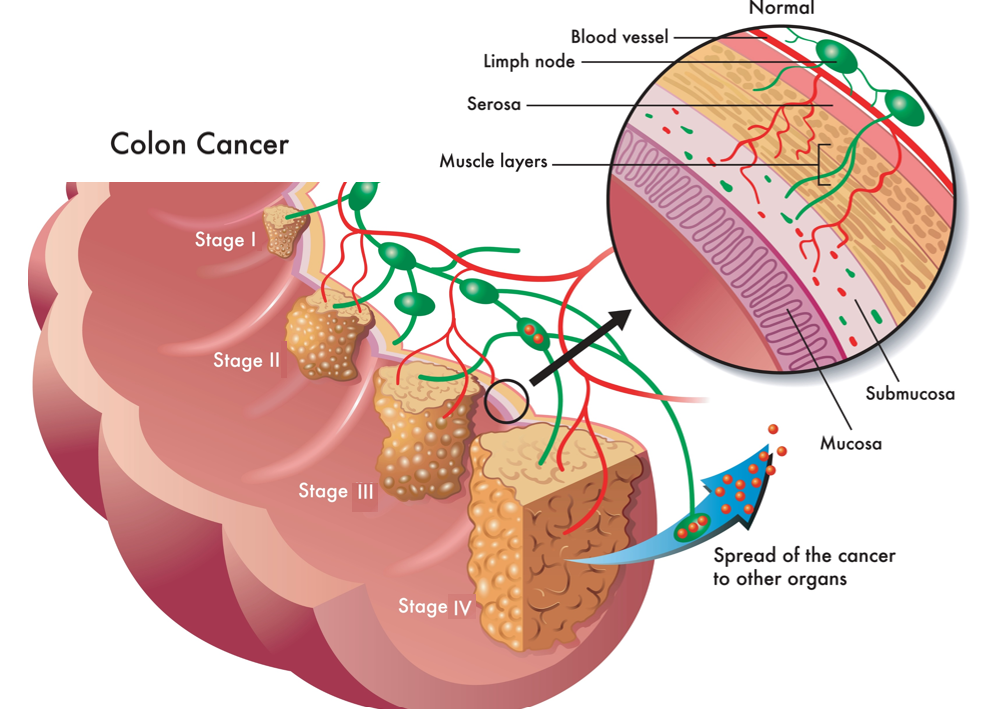Colorectal Cancer Stages and Types
Measuring colorectal cancer subtypes and stage
After a biopsy or surgery confirms colorectal cancer, a pathologist will look at the cell type and perform tests. Additional tests will be ordered to look for cancer spread through the local tissue or to distant organs. Together, these tests provide clues on how to best treat the cancer.
How stages are measured
The refers to whether the cancer has spread beyond the colon or rectum, and if so, where in the body it has spread. Measuring the and subtype of colorectal cancer helps doctors decide how to treat it. Doctors measure the of colorectal cancer by looking at the following:
- how far it has grown into the wall of the colon or rectum. Most colon cancers start in the inner lining of the colon/rectum, known as the mucosa.
- whether it has spread to nearby and, how many contain cancer cells.
- whether it has spread to other organs beyond the colon/rectum and nearby and the location and number of sites in the body where it has spread.
Doctors use imaging of the chest, abdominal and pelvis, using CT, , and PET scans to learn if the cancer has spread beyond the colon or rectum.

Colorectal cancer stages
In colorectal cancer, there are five stages.
|
|
Description |
|
0 cancers are non-invasive, also called "in situ." |
The abnormal cells have not grown beyond the innermost layer of the colon/rectum. Cancers caught and removed at 0 are very treatable. |
|
1 |
These cancers have grown beyond the inner layer of the colon or rectum, but have not penetrated through the muscle layer of the large intestine and have not spread to nearby or elsewhere in the body. |
|
2 |
These cancers have grown through the muscle layer of the colon or rectum, but have not spread to nearby or elsewhere in the body. More advanced 2 cancers may grow through all the layers of the colon and attach to nearby tissue or organs. |
|
3 |
These cancers have spread to one or more nearby or the tissue near the , but have not spread elsewhere in the body. More advanced 3 cancers have spread to a larger number of or have spread to nearby organs. |
|
4 or |
These cancers have spread to distant organs or the distant lining of the abdomen, known as the peritoneum. The most common site for is the liver. |
|
Subtype |
Description |
|
The most common subtype of colorectal cancer, making up 95 percent of all colorectal cancers. These cancers usually start as an abnormal growth known as a polyp. Some, but not all can become cancerous if they are not removed. found during colonoscopies are removed and examined to see if they are cancerous or if they were likely to become cancerous. Adenocarcinomas may be found in people with , and other genes linked to hereditary colorectal cancer. |
|
|
Mucinous |
This is a subtype of colorectal . When doctors look at these tumors under a microscope, about half will be made up of mucus. Mucinous adenocarcinomas may be more common in people with . |
|
Gastrointestinal carcinoid tumors (a type of cancer known as a neuroendocrine tumor or NET) |
Carcinoid tumors make up 1 percent of all colorectal cancers. Inherited mutations in the MEN1 gene or the gene have been linked to neuroendocrine cell cancers. NETs can also develop elsewhere in the GI tract (e.g., stomach, small intestine, pancreas) and in other organs (e.g., lung). |
|
Gastrointestinal stromal tumors (GISTs) |
GISTs are a rare type of colorectal cancer that forms in the cells that line the gastrointestinal tract. Most GISTs begin in the stomach, but they can also be found in the rectum, small intestine or colon. |
Additional tests, such as tests and genetic tests can help guide the choice of or .